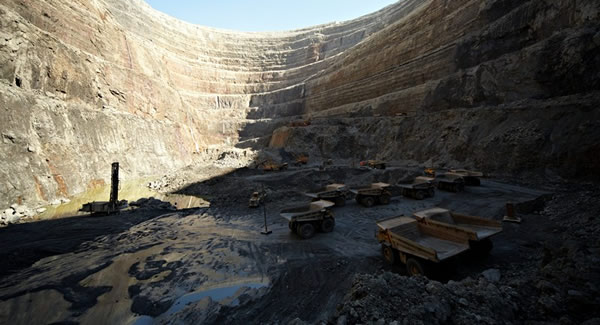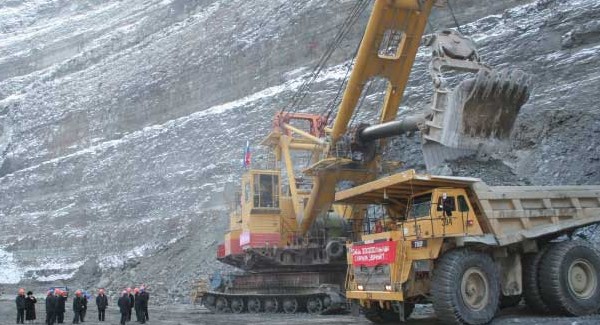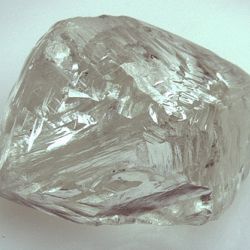When you talk with experts from Antwerp or Israel about ALROSA, they often say that “the market has changed a lot since the Russian company emerged on it in 2009.” Russia has been mining diamonds for more than 50 years, but only recently ALROSA started to be recognized as a fully competent participant of the diamond industry and moreover as its leader. During the five years under the direction of Fyodor Andreev, the company managed not only to move from the verge of bankruptcy – ALROSA was able to step out of the shade of De Beers and earn a reputation of a reliable partner.
Forfeit for being unique
“ALROSA is a unique company. It has no analogues, so it is unclear what to compare its performance and development model with and what to consider effective for it,” financial analysts complained before the recent economic downturn. Perhaps the reason for the instability in the miner’s development, which lead ALROSA to crisis in 2009, was this uniqueness.
After the discovery of the first kimberlite pipes in the USSR in the 1950s, it became clear that Yakutia is capable of becoming a new leader in the world’s diamond production. However, vast reserves of diamonds require huge investments in the construction of mining operations, especially when they have to be built in the permafrost area. Once it became clear that the reserves in open-pit mines were gradually petering out, ALROSA decided to launch a large-scale program to build underground mines in order to maintain a high level of production. One mine half a kilometer deep requires at least five years of work and about $ 1 billion of investments, while ALROSA planned to build four such mines. The company’s revenue at that time was about $ 2.5 billion a year, so the mines were built on credit.

But polished diamonds and diamond jewelry have a much greater added value than rough diamonds. Therefore, in the early 2000s, ALROSA’s management decided to try to build a “vertically integrated holding” including diamond-cutting operations and even its own jewelry manufacturing.
This drive did not stop short of expanding the company’s core business. In the wake of the global economic recovery in 2003-2007, ALROSA’s management (and, apparently, its shareholders) decided to diversify its business. The decision was in the spirit of the time for the development pattern of any company in those days and was formulated as “Buy new assets, create a holding company and go for an IPO to London.” ALROSA bought up all kinds of assets in various parts of Russia: gold mines, iron mines, oil and gas fields. At some point, the market even had it that ALROSA was not against absorbing Norilsk Nickel – despite the fact that the value of Norilsk Nickel at that time was five times greater than the value of the diamond company.
The market was growing and did not give any reasons for anxiety, so ALROSA found it easy to attract loans to buy new assets. Exploration and construction of new facilities were also conducted on credit. In fact, the miner had a lot to build: the iron ore project alone was estimated at $ 10 billion.
As a rule, troubles come without warning anyone beforehand. The financial crisis of 2008 began thick and fast and knocked down the unstable company in just a few months. ALROSA was unable to service the accumulated $ 5 billion of debt. It was necessary to continue to build new mines, though after the collapse of the market there was no demand even for rough from existing mines. The project to create a diamond-manufacturing unit and a jewelry brand proved entirely loss making, while estimating the viability of iron or gas businesses seemed appalling. Bankers were cautiously venturing the word “bankruptcy“. When Fyodor Andreev took control of the company in mid-2009, the bankers were expecting its default any day.
New marketing

The first thing ALROSA did to get out of the crisis was to introduce a fundamentally new system of sales, which permitted not only to fill up the financial gap, but also to streamline the work with customers on the market.
In the 1960s, gem-quality diamonds did not interest the Soviet Union very much – the country needed technical stones for industrial development. All gem-quality diamonds were sold through De Beers.
ALROSA obtained the right to sell part of its own rough only in the late 1990s. However, at that time Russia still had little experience of independent operations in the world diamond market, though simultaneously the country wanted to develop diamond and jewelry manufacturing. “The best quality rough diamonds were sold to the domestic market at prices that were far below the market – at a discount of about 30%,” one of the industry players recollects. “Lower quality rough went to overseas markets for sale under one-time contracts or at auctions to get the maximum price. All that remained went to De Beers.”

This pattern worked in a good market, but turned out to be quite inviable in times of crisis. After the market weakening in 2008, customers accustomed to buy rough at auctions began to demand it at half price. Russian companies, weakened by the crisis, reduced their purchases in a significant way. To make ends meet, ALROSA had to seek government support and sold almost half of its annual production to the state.
Since the summer of 2009, ALROSA changed its marketing strategy and began to tie up the first long-term contracts for the supply of rough diamonds. The system, in some of its aspects similar to the sightholder system practiced by De Beers, offered three-year contracts for the supply of specified amounts of agreed assortments of rough. ALROSA ceased to accumulate debts and started to pay them back just after six months of running this new pattern.
The company made a key breakthrough in the development of sales in 2012. Together with the Anti-Monopoly Service, ALROSA developed a document regulating its trade policy and ensuring equal access to rough for all customers regardless of their geographical location.
The new trade policy was positively received by overseas customers of ALROSA. The representatives of the company’s clientele admit that prior to the introduction of this system they “did not understand ALROSA’s reasoning behind the selection of its customers.” The trade policy of ALROSA is the most transparent on the market to this day – the principles for selecting customers and distributing boxes in other mining companies are still a sacred mystery.
The transition to a transparent system of marketing resulted in complicated relationship with domestic diamond manufacturers. Russian companies, accustomed to get high quality rough at low prices, were not ready to move to a market economy definitely. It took several months to harmonize the amount of sales and their product range for domestic diamond cutters, and eventually they were able to find their niche. The results speak for themselves: in 2008, ALROSA sold $ 2.5 billion worth of rough diamonds, while in 2013 the company’s sales reached $ 5 billion.
New strategy
The new managerial team proposed a new strategy for the company focused on diamond mining and complete withdrawal from non-core activities. Any non-core expenses inevitably affect the cost of one carat of rough diamonds, which undermines the company’s competitive strength. It should be kept in mind that ALROSA’s main revenue is still coming from diamond sales.
[two_third]The strategic goal of the company is to preserve its leadership in the world diamond market. To do this, ALROSA will increase its diamond output from the current 36 million to 41 million carats over the next few years. This will largely happen due to the fact that the company while recovering from the crisis did not abandoned the program of constructing underground mines. In the summer of 2014, ALROSA commissioned the last and largest of the four underground mines – Udachny. These mines required large investments, but they will ensure stable production in Yakutia in the years ahead. Currently, about a quarter of diamonds mined by ALROSA is extracted at underground mines and in a few years this figure will reach 40%.[/two_third][one_third_last]
“The strategic goal of the company is to preserve its leadership in the world diamond market. “
[/one_third_last]
The successfulness of this strategy has been confirmed not only by financial performance of the company, which has grown substantially since 2009. The best evidence is a high level of confidence in the company on the part of demanding foreign investors who bought shares in ALROSA during its IPO carried out in late 2013.
Standard for industry
 Diamond market players were differently viewing the IPO of ALROSA, explaining that “it had not very much to deal with the actual market.” Still, if you look more closely into the matter, the floating of shares issued by the Russian company was perhaps even more useful to the diamond pipeline than to its shareholders. Bringing its documents in compliance with the stock exchange standards, ALROSA turned the most open and transparent of the existing diamond companies. It publishes everything, from financial statements to data on tenders for the supply of stationery to its offices.
Diamond market players were differently viewing the IPO of ALROSA, explaining that “it had not very much to deal with the actual market.” Still, if you look more closely into the matter, the floating of shares issued by the Russian company was perhaps even more useful to the diamond pipeline than to its shareholders. Bringing its documents in compliance with the stock exchange standards, ALROSA turned the most open and transparent of the existing diamond companies. It publishes everything, from financial statements to data on tenders for the supply of stationery to its offices.
By and large, buyers of rough diamonds do not care about quotes for ALROSA shares. But they do care about how much rough is put up by the company for sale and about how much more diamonds the miner is going to offer from its stocks. ALROSA reveals even prices for sold rough – a kind of luxury not demonstrated by De Beers or other mining companies.
[two_third]ALROSA requires the same level of transparency from its customers. No company can be a long-term client of ALROSA until it demonstrates its financial statements and proves its business is sufficiently stable. In addition, ALROSA has introduced for its customers the concept of “responsible business practices” under which every long-term customer must confirm that it complies with all the requirements of the Kimberley Process, fighting corruption and does not trade in synthetic diamonds. ALROSA’s managers even let it slip to the media that the company will track the customers engaged in price manipulation in the market – buying up certain categories of rough, creating its deficit and then throwing the accumulated stock into the market. ALROSA threatens to exclude from the list of long-term partners for violation of any of the “ethical business norms.”[/two_third][one_third_last]
“ALROSA requires the same level of transparency from its customers.”
[/one_third_last]
In 2014, a couple of years after the Russian company introduced a strict system of financial and corporate criteria for its customers, the same practice was brought into action by De Beers.
[two_third]After 10 years of instability, ALROSA has found its development strategy. Today ALROSA is the world’s largest diamond producer having the largest resource base, enjoying the reputation of a reliable and stable partner and defining business standards for the entire industry. The only question asked by diamond market players after Fyodor Andreev’s resignation as the company’s CEO is whether ALROSA will preserve this stability.[/two_third][one_third_last]
“After 10 years of instability, ALROSA has found its development strategy. Today ALROSA is the world’s largest diamond producer having the largest resource base.”
[/one_third_last]

